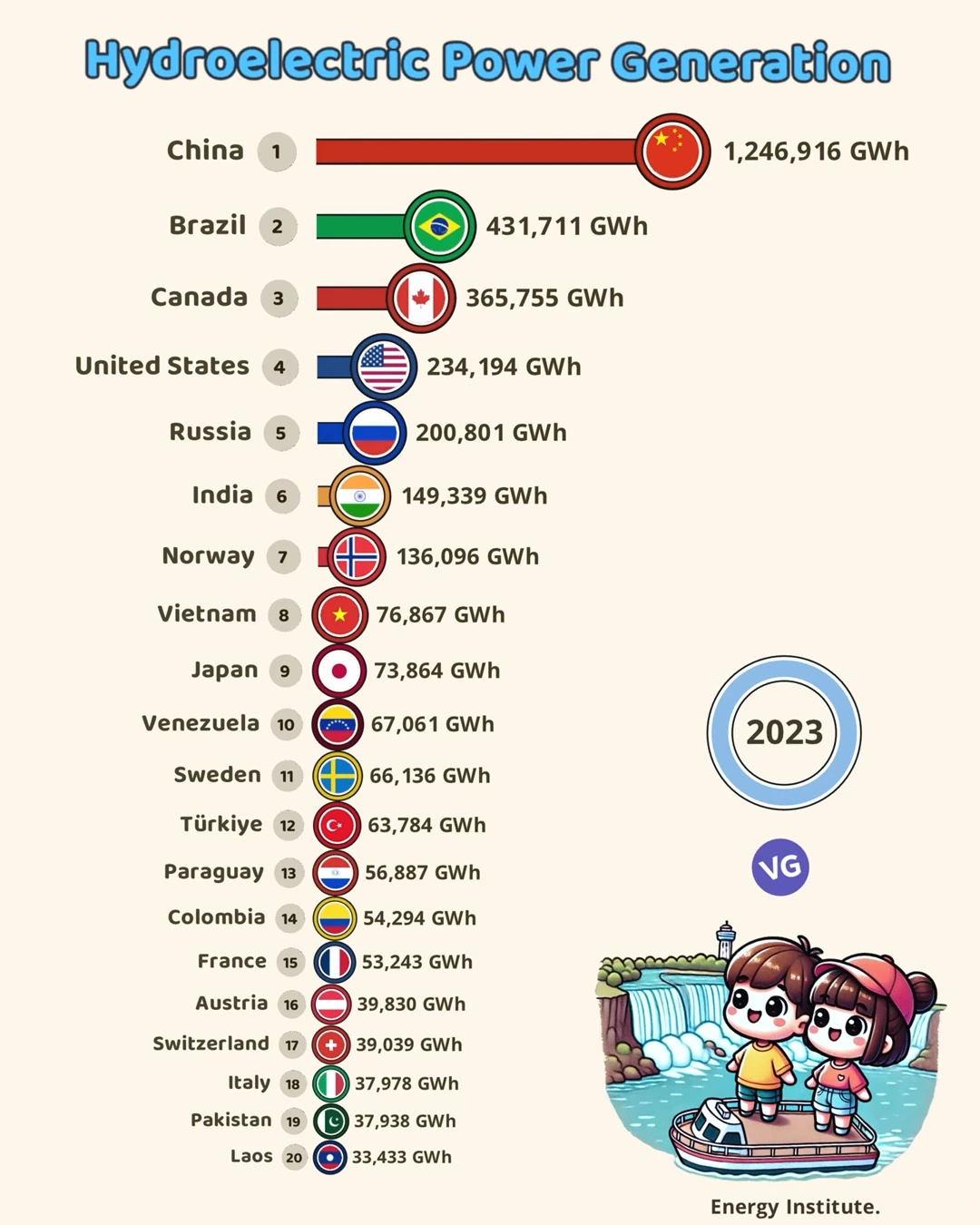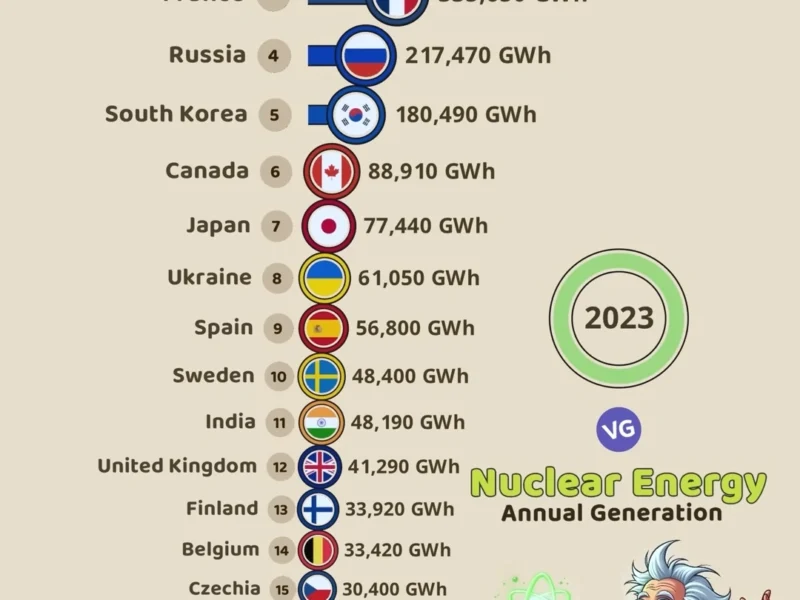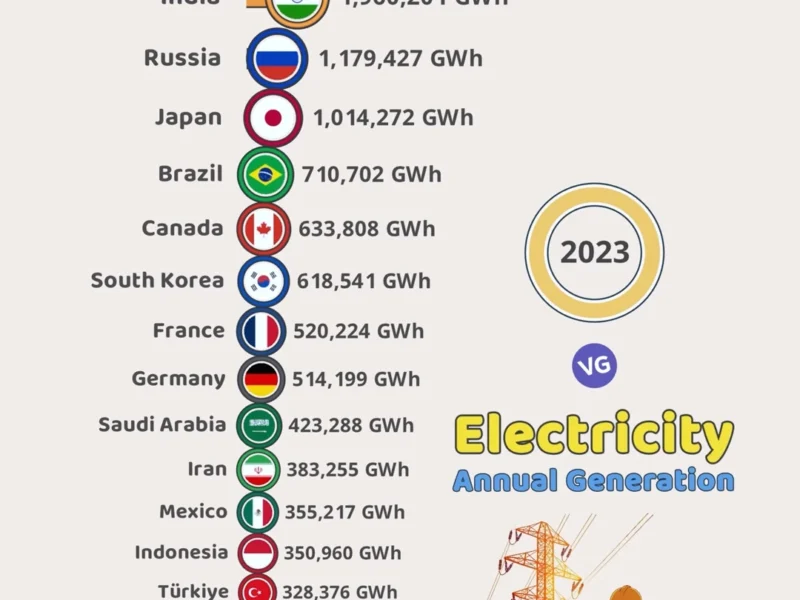In an era where sustainable energy solutions are more crucial than ever, hydroelectric power continues to play a pivotal role in the global energy landscape. Recent data from the Energy Institute reveals fascinating insights into which nations are leading the charge in hydroelectric power generation, with some surprising findings that highlight the intersection of geography, infrastructure, and environmental policy.
Hydroelectric Power Generation 2023
| Rank | Country | Generation (GWh) |
|---|---|---|
| 1 | 🇨🇳 China | 1,246,916 |
| 2 | 🇧🇷 Brazil | 431,711 |
| 3 | 🇨🇦 Canada | 365,755 |
| 4 | 🇺🇸 United States | 234,194 |
| 5 | 🇷🇺 Russia | 200,801 |
| 6 | 🇮🇳 India | 149,339 |
| 7 | 🇳🇴 Norway | 136,096 |
| 8 | 🇻🇳 Vietnam | 76,867 |
| 9 | 🇯🇵 Japan | 73,864 |
| 10 | 🇻🇪 Venezuela | 67,061 |
| 11 | 🇸🇪 Sweden | 66,136 |
| 12 | 🇹🇷 Türkiye | 63,784 |
| 13 | 🇵🇾 Paraguay | 56,887 |
| 14 | 🇨🇴 Colombia | 54,294 |
| 15 | 🇫🇷 France | 53,243 |
| 16 | 🇦🇹 Austria | 39,830 |
| 17 | 🇨🇭 Switzerland | 39,039 |
| 18 | 🇮🇹 Italy | 37,978 |
| 19 | 🇵🇰 Pakistan | 37,938 |
| 20 | 🇱🇦 Laos | 33,433 |
Global Leaders Analysis
China’s Dominant Position
Standing head and shoulders above other nations, China’s hydroelectric output of 1,246,916 GWh is nothing short of remarkable. This figure isn’t just impressive—it’s nearly three times the output of second-placed Brazil. China’s commitment to hydroelectric power reflects its broader strategy to reduce dependency on fossil fuels while meeting the enormous energy demands of its 1.4 billion population. The Three Gorges Dam, the world’s largest hydroelectric facility, exemplifies China’s ambitious approach to renewable energy infrastructure.
The Americas: A Powerhouse Region
The Western Hemisphere shows remarkable strength in hydroelectric generation, with Brazil (431,711 GWh), Canada (365,755 GWh), and the United States (234,194 GWh) all ranking in the top four. Brazil’s strong performance can be attributed to its extensive river systems, including the Amazon and its tributaries, while Canada’s success stems from its abundant freshwater resources and long-standing commitment to hydroelectric infrastructure.
European Innovation
Despite their smaller geographical size, European nations feature prominently in the rankings. Norway, producing 136,096 GWh, leads the European contingent at seventh place globally. This achievement is particularly impressive considering Norway’s population of just 5.4 million, making it one of the highest per-capita producers of hydroelectric power. Other European nations like Sweden, France, Austria, and Switzerland also make the top 20, demonstrating the continent’s commitment to renewable energy sources.
Future Perspectives
Emerging Markets and Future Potential
Several developing nations show significant hydroelectric capacity, suggesting a promising future for renewable energy in emerging economies. Vietnam (76,867 GWh) and Laos (33,433 GWh) represent Southeast Asia’s growing investment in hydroelectric infrastructure. Meanwhile, Pakistan’s presence in the top 20 (37,938 GWh) indicates the potential for hydroelectric development in South Asia.
Challenges and Considerations
While these figures are impressive, they also raise important questions about environmental impact and sustainability. Large-scale hydroelectric projects can significantly affect local ecosystems and communities, requiring careful balance between energy needs and environmental preservation. Additionally, climate change-induced weather patterns may impact future hydroelectric reliability in some regions.
Looking Forward
The 2023 data suggests that hydroelectric power will remain a crucial component of the global renewable energy mix. With many countries pushing for carbon neutrality in the coming decades, we can expect continued investment in hydroelectric infrastructure, particularly in regions with untapped potential.
However, future development will likely focus on more sustainable approaches, including run-of-river projects and small-scale installations that minimize environmental impact while maintaining energy output. The success stories of countries like Norway and Brazil provide valuable lessons for nations looking to expand their renewable energy capacity through hydroelectric power.
As we progress through the 2020s, the role of hydroelectric power in achieving global climate goals cannot be understated. The data from 2023 shows that while traditional powerhouses maintain their strong positions, new players are emerging, suggesting a bright future for this crucial renewable energy source.



